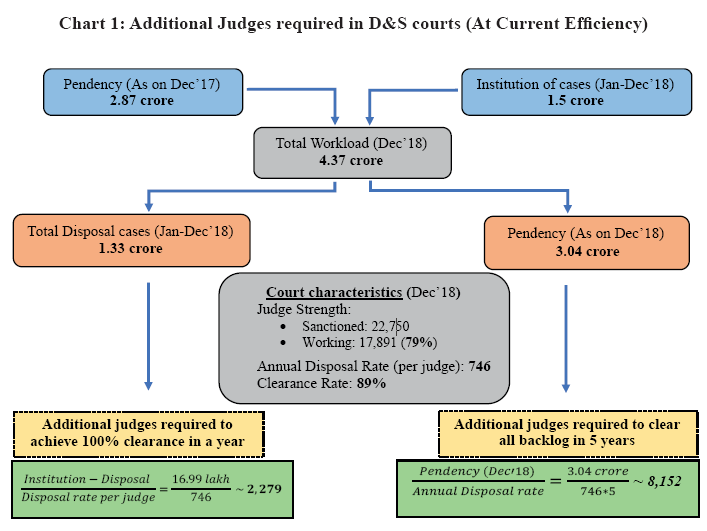The Economic Survey 2019 has identified several root causes for the mammoth pendency of 3.5 crore cases in Courts. It has offered valuable suggestions for improving efficiency, which includes reducing the number of holidays that the Courts merrily take at the cost of the poor litigant
Courts work less than Government
One of the shocking revelations of the Economic Survey is that the Government officials work for a longer number of days as compared to their counterparts in the Judiciary.
While the Central Government offices will be open for 244 working days in 2019, the Supreme Court will work for only 190 days.
The Supreme Court enjoys 49 days of holiday for summer vacations, 14 days for winter break, and a further 18 days for Holi, Diwali and Dussehra.
The High Courts work on average for 232 days while Subordinate courts work for 244 days.
“Increasing the number of working days may improve productivity of the Supreme Court and in some High Courts, but is unlikely to significantly impact lower courts,” the survey states.
100% case clearance if 3,000 judges are appointed
The Economic Survey explains that a case clearance rate of 100 per cent (i.e. zero accumulation) can be achieved with the addition of merely 2,279 judges in the lower courts and 93 in High Courts even without efficiency gains.
This is already within sanctioned strength and only needs filling vacancies, it is stated.
In order to clear all the backlog in the next five years, further 8,152 judges are needed to be appointed in the subordinate courts.
It is pointed out that High Court judges are working at 62 per cent of their sanctioned strength.
Their case clearance rate is 88 per cent and each judge achieves an average disposal rate of 2,348 cases per year.
The backlog of cases as on June, 2018 was 44.40 lakh. In order to reach 100 per cent CCR, just 93 additional judges need to be appointed.
This is also already within the present sanctioned strength for High Courts.
To clear all backlogs in the next five years, the High Courts need a further 361 additional judges.
As regards the Supreme Court, an increase in sanctioned strength by six judges will enable the entire backlog to be cleared, it is claimed.

Already Subordinate Court Judicial Officers like Magistrates and Junior Civil Judges work load is very high. They don’t have proper staff and infrastructure facilities also. If the cases are pending before the Courts is complicated clauses in the Acts or confusing or contradictory clauses in various Acts.
At district level only few Advocates are having enough cases or more cases. Majority of the Advocates don’t have guaranteed monthly income like regular employees. Allotment of funds to strengthen the Judiciary is also very less. For the past 30 years how many crores were allotted, how many crores are required to strengthen Judiciary has to be analyzed.
It is the duty of the Govts. to provide enough infrastructure and trained Staff to Judiciary. Increasing the Judges from the Subordinate Courts, allowing the litigants to settle out of court, if the case will end during the pre-litigation period, it has to be settled at this stage itself, these are all only few remedies.
Precisely say, unequal distribution of cases is the main root cause. At the Subordinate Court or district level Advocates don’t have guaranteed monthly income, don’t have enough opportunities to grow, don’t have proper medical facilities, don’t have proper social and economic support, then how these Advocates will grow? or settle in their lives? what about their right to live with dignity? Pendency or reduction of cases has to be analyzed in the context of Advocates and facilities available point of view. In many Court premises, Advocates don’t have proper Bar Association Halls also.
Govts. have to allocate hundreds of crores for the next decade to strengthen Judiciary from the grassroots. A Govt. employee or an employee is having guaranteed monthly income whereas an individual Advocate did not have guaranteed monthly income. How to uplift these professionals is also has to be examined by Niti Aayog.
People have to remember Judicial Officers are also human beings.
The job of a judge is difficult. Nobody understands this. Hearing all the arguments and analyzing facts and coming to decisions is a very difficult job taking many hours and stressful job. They need rest to recoup their mental agility. One can understand only if he works as a judicial authority. Criticism is easy. One leading luminary appears to have told jocularly when he was offered judgeship that he can argue nonsense for a fer hours a day bot cannot hear nonsense for the whole day. The has to hear all sorts of arguments and study to come to a decision needs adequate rest for efficient functioning. Mere comparisons are odious.
Reduce?? Why not remove? Sitting in air-conditioning court rooms working is far better than the those who work in under normal conditions. Years and years of waiting slays justice while judiciary enjoys vacation at hill stations. Apart from growing number of cases, many 15-20-30 or some 40 years old litigation is pending in apex court. The trust in judiciary is slowly fading lately. People prefer to settle disputes out of court.